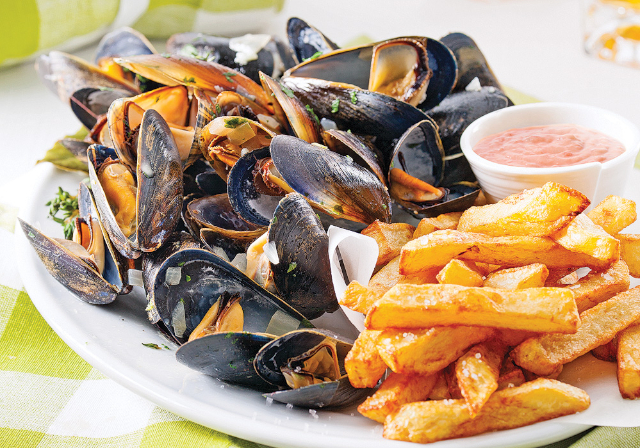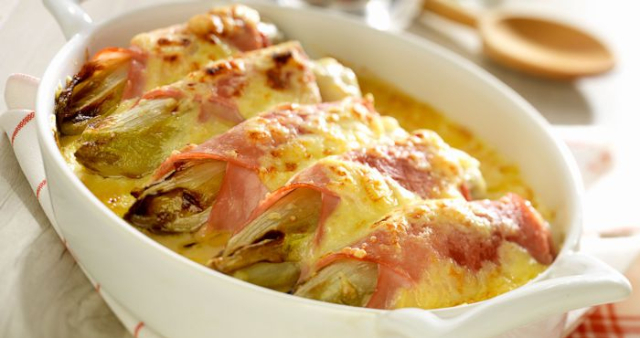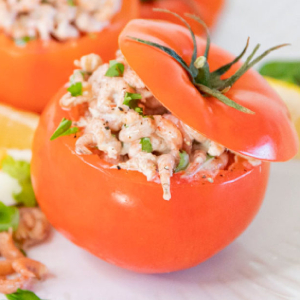In the middle of the crowded northern European map you’ll find plucky little Belgium, a haven for two distinct cultures, each with its own language and customs. And between them, they’ve developed a unique national cuisine which has given at least one golden gift to the world…
 Belgian Frites: The original ‘French’ Fries. A national treasure!
Belgian Frites: The original ‘French’ Fries. A national treasure!
Belgium is a shining gem in the crown of northern Europe. Situated between France, the Netherlands, Germany and Luxembourg. Al roads literally lead to Brussels, the capital, which also happens to be the home of NATO Headquarters. The population is made up of two distinct cultures: The Flemings in the north and west speak Belgian Dutch, also known as Flemish. The Walloons, who inhabit the south and east portions of the country, speak dialects of French.
Belgian cooks love veggies in season and among the most commonly used are: potatoes, leeks, white asparagus and Belgian endive. Their most beloved seafood is mussels, followed closely by grey shrimp and Sole. Other staples include a variety of meats, cheeses and – in the French tradition – lots of butter.
According to Wikipedia: “[Classic] Belgian Cuisine […] is widely varied with significant regional variations while also reflecting the cuisines of neighbouring France, Germany and the Netherlands. It is sometimes said that Belgian food is served in the quantity of German cuisine but with the quality of French food.”
On our menu today…
Frites: ‘French’ Fries. Belgium’s biggest gift to the world. Invented not in France, but in Belgium c. 1781, Frites are traditionally thicker than classic French version of fries but not as thick as the wedges that have taken the bar food menus of the world by storm in recent years. The Belgian classic is cooked twice; first scalded (par-cooked), then fried again at higher temperature to crisp the outside leaving the center soft and flaky. In spite of the penchant elsewhere to eat fries with Ketchup or gravy, The Belgians have always eaten them with mayonnaise. And the Germans, just across the border, prefer them with Mustard. Go figure.
Moules Frites: Mussels with Frites. This is one of the national dishes of Belgium, and a runaway favourite of the people. More than 30 million tonnes of Moulles are eaten in Belgium every year – more than 3 kg / 6 lb. person!

The mussels are simmered in the French way – with butter, white wine and shallots – and garnished with Parsley. Frites are served on the side in the classic presentation.
Sole meunière: Belgium’s national fish dish. But a steal from Francr. A beautiful Sole filet is dipped in flour and fried in butter. A squeeze of lemon juui9ce and some chopped parsley are added to make a luciuous butter sauce. The Sole is traditonally served with some kind of potatoes: Frites, boiled or mashed.
Boulets: Meatballs. The meatballs are a mixture of beef and pork, with fresh bread crumbs, onions, parsley and eggs. Pretty standard stuff. Where the classic Belgian touches come in is the presentation:

Frikadellen-style met krieken are fried in butter and topped with Belgian cherry sauce. In Flanders, balletjes style meatballs are covered with Tomato sauce. In Brussels, boulets à la Liégeois is favoured; meatballs with a rich beef stock and app0le butter sauce.
Carbonade flamande eor stoofvlees: Sweet and sour steak and ale stew. Another national favourite. This Belgian classic comes in as many versions as there are cooks who make it. Ingredients generally include beef, dark beer, bread, onions, salt, pepper, bay leaf, thyme and spices. Depending on the season and family custom, carrots, mushrooms, bacon, red wine, shallots and even dark chocolate may be added. The meat is marinated for at least 24 hours and the stew is simmered long and low – up to 8 hours; at least until the meat is fall-apart tender.
Chicon au gratin: Ham and endive gratin. A popular ‘comfort food’ side dish. Endive hearts are wrapped with thin slices of boiled ham and baked until the lettuce is cooked through.

The wraps are then doused in a thick, rich cheese sauce just before serving. Endive is enjoyed in a whole laundry list of dishes in Belgium – so beloved that they call it ‘White Gold’.
Stoemp: A vegetable mash. This universal Belgian side dish is basically a mixture of a variety of veggies, always including mashed potatoes and may include endive, kale, onions, carrots, turnips, Brussels sprouts, spinach, and various greens – all coked to a very soft consistency and puréed. The flavour is indescribable! It often accompanies beef, bacon or a variety of sausages.
Crevette Grise: White shrimp. Harvested from the salt waters along the coast, these little poppers are enjoyed everywhere in the country as bar snacks and in more formal dishes, such as Stuffed Tomatoes (see photo, top of page) or Shrimp Cakes. They’ll even bring you a bowel of breaded, deep-fried Crevette Grise by themselves as a snack or starter i n most Belgian seafood restaurants.
And those are just their national dishes!
Tomorrow, we’ll survey Belgian Breads – another adventure in two-way borrows and steals with Northern European neighbours.
~ Maggie J.

